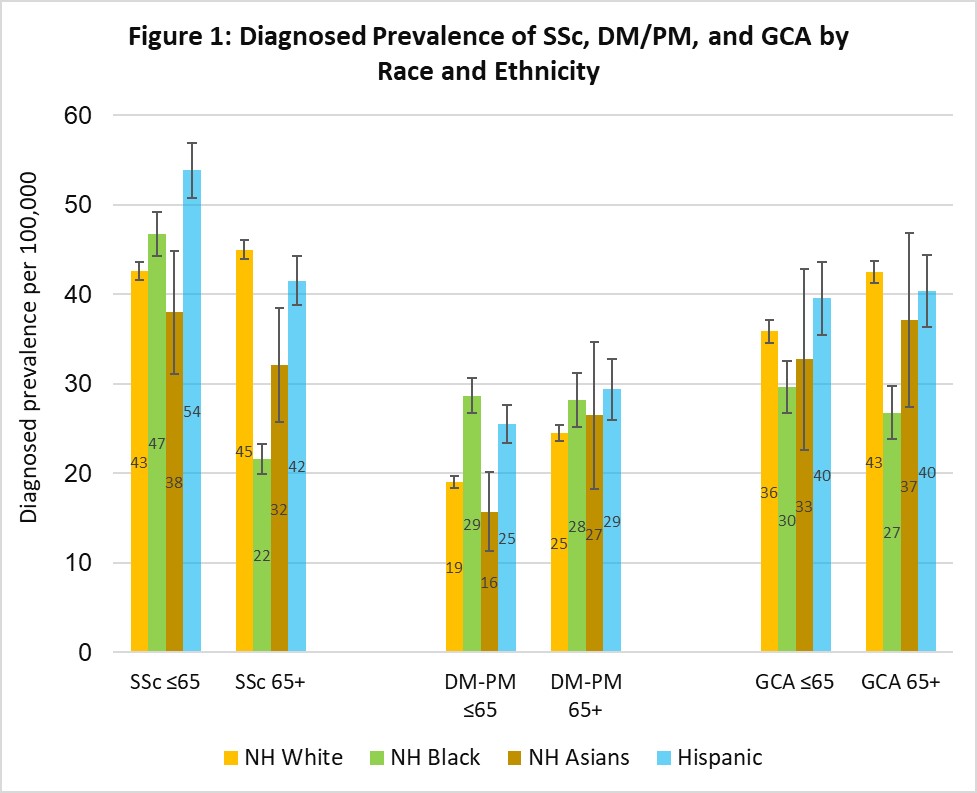Session Information
Date: Saturday, November 7, 2020
Title: Epidemiology & Public Health Poster II: OA, Osteoporosis, & Other Rheumatic Disease
Session Type: Poster Session B
Session Time: 9:00AM-11:00AM
Background/Purpose: Epidemiological studies suggest differences in the prevalence and disease severity of certain autoimmune diseases by race and ethnicity. In this study, we evaluate the distribution of three rare connective-tissue diseases i.e., systemic sclerosis (SSc), dermatomyositis/polymyositis (DM/PM), and giant cell arteritis (GCA), in different racial/ethnic groups in the United States using data from electronic health records (EHR).
Methods:
We restricted the study population to patients aged 20 or older, who had submitted at least two insurance claims in 2018 (Real World Data. Decision Resources Group, 2020), and had no missing information in their EHR regarding age, gender, and race/ethnicity. We categorized the patients with respect to age (≤65 versus 65+ for SSC and DM/PM; 50-65 versus 65+ for GCA) and race/ethnicity (non-Hispanic White (NHW), non-Hispanic Black (NHB), Hispanic, and non-Hispanic Asian (NHA)). To be considered a case, a patient was required to have at least two diagnoses recorded for each autoimmune disease in 2018. For each racial/ethnic category, we estimated the age-group-specific diagnosed prevalence of SSc, DM/PM, and GCA, and calculated the diagnosed prevalence ratios for NHBs, Hispanics, and NHAs using NHWs as the referent population.
Results: In persons aged ≤65, we observed a significantly increased risk of SSc in NHBs (RR=1.10; 95% CI = 1.04-1.16) and Hispanics (RR = 1.26, 95% CI = 1.19-1.35) as compared to the NHW population, but not in NHAs (RR = 0.89, 95% CI = 0.74-1.07). Interestingly, the pattern was reversed in NHBs aged 65+, with a significantly lower diagnosed prevalence of SSc (RR = 0.48; 95% CI = 0.44-0.52) as compared to NHWs. We also observed a reduced risk of SSc in Hispanics (RR=0.92, 95% CI = 0.86-0.99) and in NHAs (RR = 0.71; 95% CI = 0.58-0.87) in the older age-group. The risk of DM/PM in both age-groups was elevated in NHBs (ages ≤65: RR = 1.51, 95% CI = 1.40-1.63; ages 65+: RR = 1.15, 95% CI = 1.03-1.29) and Hispanics (ages ≤65: RR = 1.34, 95% CI = 1.22-1.47; ages 65+ RR = 1.20, 95% CI = 1.06-1.35) as compared to NHWs, but not in NHAs (ages ≤65: RR = 0.83, 95% CI = 0.62-1.10; ages 65+: RR = 1.08, 95% CI = 0.79-1.48). We observed a significantly reduced risk of GCA in NHBs in both age groups (ages ≤65: RR = 0.83, 95% CI = 0.75-0.92; ages 65+: RR = 0.63, 95% CI = 0.56-0.71) as compared to NHWs, while no significant difference was observed in Hispanics (ages ≤65: RR = 1.10, 95% CI = 0.99-1.23; ages 65+: RR = 0.95, 95% CI = 0.86-1.05) and in NHAs (ages ≤65: RR = 0.91, 95% CI = 0.67-1.25; ages 65+: RR = 0.87, 95% CI = 0.67-1.14).
Conclusion: Our results concur with findings of other epidemiological studies that have observed a higher prevalence of SSc and DM/PM and a lower prevalence of GCA in certain ethnic groups as compared to NHWs. However, the lower prevalence of SSC observed in NHBs and Hispanics aged 65+ warrants further investigation, as it may indicate early mortality in these patients known to experience more severe disease.
 Diagnosed prevalence of SSc, DM/PM, and GCA by race and ethnicity
Diagnosed prevalence of SSc, DM/PM, and GCA by race and ethnicity
 Risk ratios (95% confidence intervals) for SSc, DM/PM, and GCA _ minority ethnicities versus non-HIspanic Whites
Risk ratios (95% confidence intervals) for SSc, DM/PM, and GCA _ minority ethnicities versus non-HIspanic Whites
To cite this abstract in AMA style:
Goonesekera S, Bansal A, Tadwalkar S, Isherwood A. The Prevalence of Systemic Sclerosis, Dermatomyositis/Polymyositis, and Giant Cell Arteritis in the United States by Race and Ethnicity: An Analysis Using Electronic Health Records [abstract]. Arthritis Rheumatol. 2020; 72 (suppl 10). https://acrabstracts.org/abstract/the-prevalence-of-systemic-sclerosis-dermatomyositis-polymyositis-and-giant-cell-arteritis-in-the-united-states-by-race-and-ethnicity-an-analysis-using-electronic-health-records/. Accessed .« Back to ACR Convergence 2020
ACR Meeting Abstracts - https://acrabstracts.org/abstract/the-prevalence-of-systemic-sclerosis-dermatomyositis-polymyositis-and-giant-cell-arteritis-in-the-united-states-by-race-and-ethnicity-an-analysis-using-electronic-health-records/
